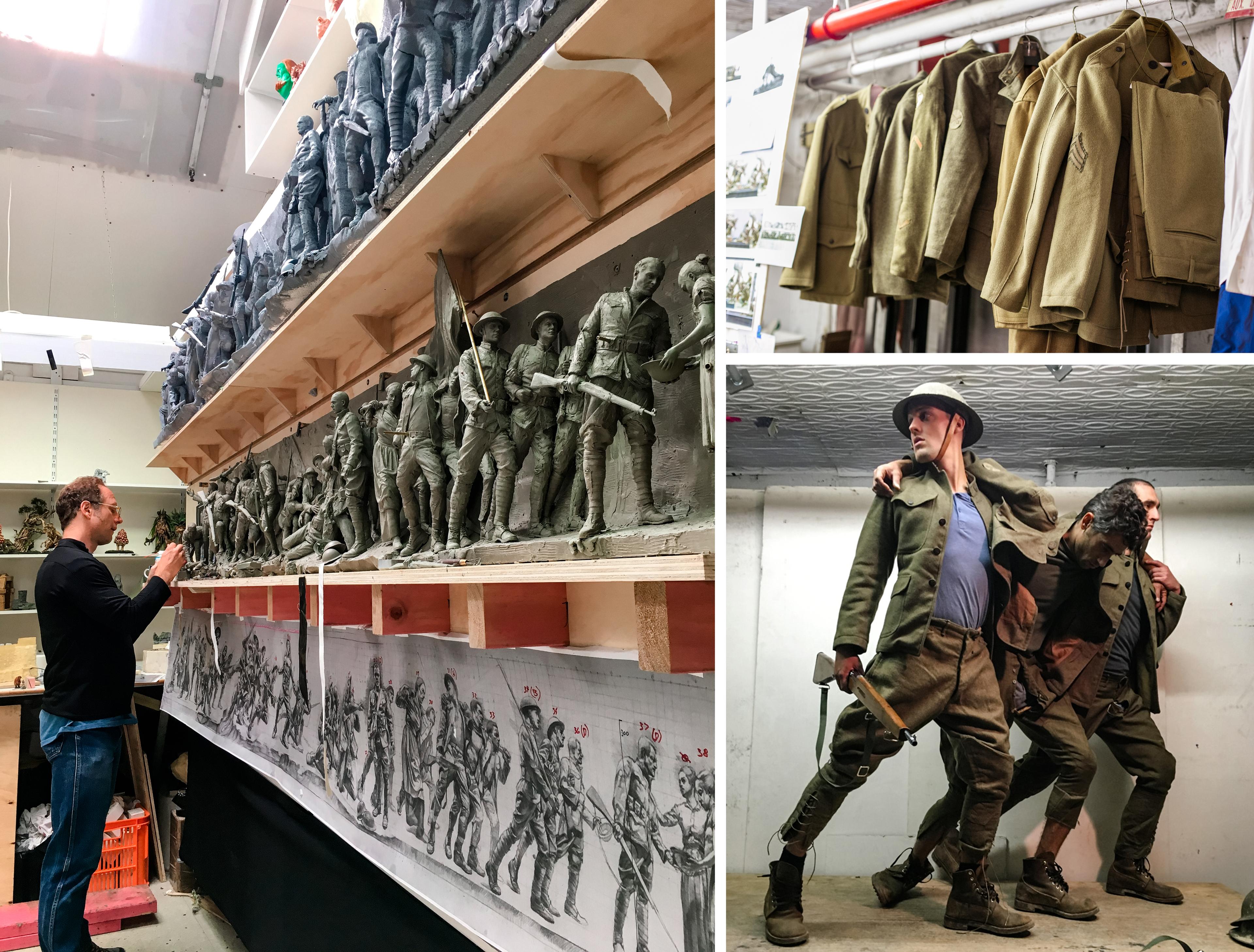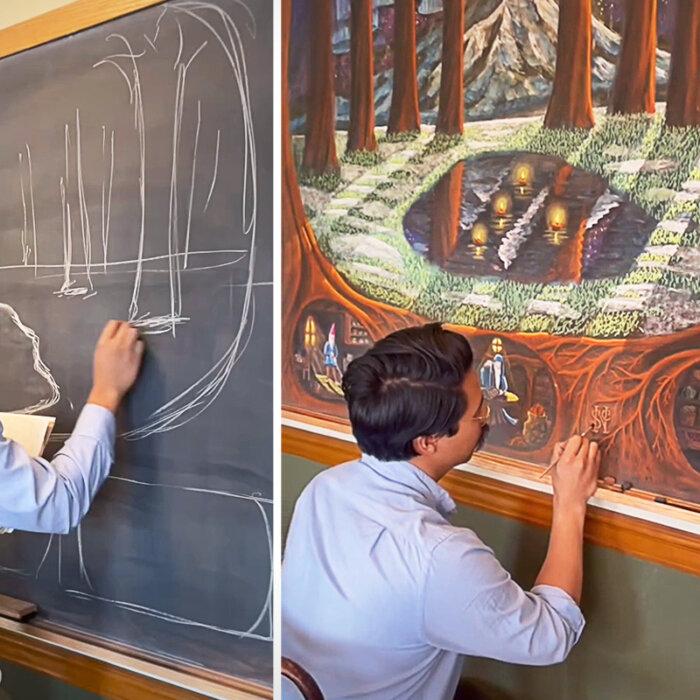As the sun dips below the horizon, its last rays illuminate the figure of a solemn, uniformed soldier as he kneels at the feet of his young daughter.
She hands him his helmet and they say their goodbyes for what could be the last time.
It’s a familiar but heart-wrenching scene for the thousands of Americans who have sent their loved ones off to war, unsure if they will ever return. On Sept. 13 in Washington, a similar scene will be depicted with the unveiling of the National World War I Memorial, nearly a decade after its conceptualization.
The monument will be unveiled at 7:19 p.m. as the sun sets during a candlelight vigil.
The relief sculpture, dubbed “A Soldier’s Journey,” follows the story of one American soldier as he leaves his family to join his brothers in arms on the front lines of “the war to end all wars” in Europe.
Resolute, the soldier leads the charge into battle, only to come face to face with the soul-crushing realities of war. Transformed, he returns home to his daughter and hands her his helmet once more, from which she divines the inevitability of another world war.
Master sculptor Sabin Howard, the artist behind the project, said he hopes the sculpture will bring people together in a time when public monuments have become a source of political tension and division.
“I wanted to make an art form that would be understandable by all, no matter what their socioeconomic level or education or beliefs,” he told The Epoch Times. “It’s a piece that really hearkens back to what the Renaissance art did, which is, it speaks about our potential, about what we can be, and in so doing, I think it’s a great unifier.”


(Top) “A Soldier’s Journey” by Sabin Howard. (Bottom Left) A part of the small maquett for “A Soldier’s Journey” where a uniformed soldier kneels at the feet of his young daughter before leaving for the war. (Bottom Right) A part of the small maquett for “A Soldier’s Journey” where the soldier returns home to his daughter and hands her his helmet. (Illustration by The Epoch Times, Courtesy of Traci Slatton Howard, Courtesy of Sabin Howard)
A Big Leap
From the start, Mr. Howard had a unique perspective on the world that was informed by his bicultural background.
As both an American and an Italian, he split his time growing up between the modern, fast-paced streets of New York and the museums and architectural landmarks of Turin, Italy.
With those two cultural powerhouses serving as the backdrop for his childhood, it may be unsurprising to those on the outside looking in that Mr. Howard eventually decided at age 19 to become an artist. But for the man himself, the decision was not quite so clear.
“I couldn’t draw at all,” he recalled. “I started at zero, and now I’m making a monument that’s probably the biggest classical figurative sculpture in the last 200 years. It’s a big leap.”
He began his foray into the arts in the early 1980s at the Philadelphia College of Art and went on to earn his master of fine arts from the New York Academy of Art.
In the decades since, he has received numerous commissions, taught classes at the graduate and undergraduate levels, and sold his works to museums and private collectors around the world.
Mr. Howard’s works have included life-size statues of the Greek gods Hermes, Aphrodite, and Apollo, as well as many smaller pieces. By the time he entered the global competition in 2015 to sculpt the National World War I Memorial, he had spent 75,000 hours sculpting from live models.


(Left) Sabin Howard’s works include “Persistence,” “Apollo,” and fragements of “Thinking States.” (Right) Mr. Howard works on a bust of Aphrodite in his studio in the Bronx neighborhood of New York City on on Sept. 13, 2016. (Courtesy of Sabin Howard, Benjamin Chasteen/Epoch Times)
He and his team beat out 360 entrants from around the world to win the commission. And once complete, “A Soldier’s Journey” will be his crowning achievement.
A Radical Return to Realism
Standing 10 feet high and 58 feet long, “A Soldier’s Journey” and the life-like figures it immortalizes reflect Mr. Howard’s traditional arts education studying the works of such Renaissance masters as Michelangelo, Da Vinci, and Raphael.
That fact alone sets it apart from the works of Mr. Howard’s contemporaries.
“It’s a very radical sculpture for these days. It goes completely against the art narrative,” he said.
Mr. Howard noted that artists today have largely abandoned the realism of the Renaissance in favor of more abstract concepts and media. But in his view, the modern style isn’t so much art as a “giant scam.”
“We don’t have great artists in our country anymore. Everything has gone to crap,” he said, attributing the change to a politicization of the public education system.
He noted that public schools have shifted away from teaching American greatness toward highlighting America’s imperfections. That change, he contends, has led to increasing public disinterest in art—which has traditionally served as a unifier—and a heightened focus on divisive political issues.
But with his piece, Mr. Howard said he hopes to unite the country.
“These soldiers were all Americans—they all bled the color red. And they were neither Democrats nor Republicans, they were just Americans. And so, this is really different than what’s going on today.”

Sabin Howard sculpts the maquette of “A Soldier’s Journey” at Weta Workshop in Nov. 2017. (Courtesy of Sabin Howard)
Monument Destruction
“A Soldier’s Journey” will soon be installed in Pershing Park, less than half-mile from the statues that protesters defaced in Lafayette Square in June.
Armed with smoke bombs and spray-paint, pro-Palestinian demonstrators swarmed the square on June 8 in protest of Israel’s war with the Gaza-based terrorist group Hamas. When they left, such messages as “Death to Amerikkka” and “Free Palestine” were emblazoned on statues honoring the Marquis de Lafayette and the Comte de Rochambeau, two Frenchmen who served as generals in the Continental Army during the Revolutionary War.
None of the protesters were arrested—a fact Mr. Howard lamented.
“If I were to go out and destroy public property, I would have a nice dinner in jail tonight,” he noted. “But a pro-Hamas supporter spray-paints on a sculpture that was done in the 1800s in front of the White House and nothing happens? I am very, very concerned.”
Now, pro-Palestinian protesters have resurrected those tactics in a high-stakes election year.
“I think that it is very interesting that we are having this happening in an election year, and last time this happened was in an election year,” Mr. Howard said. “So, I would ask the public to look at that and ask, ‘What are their true motives here?’”
“History is the cultural umbrella that binds us all together,” he said. “So, when you destroy that, you create a void. And I believe that this void is being created on purpose to rewrite history.”
As part of that initiative, the Philadelphia-based Monument Lab conducted a national monument audit to assess the nature of the current commemorative landscape, concluding that it is “overwhelmingly white and male.”

Protesters graffiti the Robert E. Lee statue in Richmond, Va., on Jan. 17, 2021. (Ryan M. Kelly/AFP via Getty Images)
To remedy that, the audit’s directors go beyond calling for new memorials telling previously untold stories. They also say that existing monuments should be “held accountable to history.”
The Mellon Foundation did not respond to a request for comment, while a spokesperson for Monument Lab declined to comment.
But to Mr. Howard, this “dismantling” of historical artwork appears to be a politically driven attempt to denigrate and destroy the nation’s founding principles and values.
“I see this as a subjugation of ideas,” he said. “And the subjugation of ideas that we’re seeing right now with the destruction of sculptures and Western civilization is an attack against things that are sacred and have had traditional value.”
‘Construct, Build’
In Mr. Howard’s eyes—the eyes of an artist—history does not need to be “repaired” but learned from.
“I could never have made the piece of art that I made unless I had studied the history of art that came before me—so that I could take from it, I could draw from that circle, and reapply it to my contemporary standards,” he said.
Praising his own traditional arts education, the sculptor said ideas should be debated, not forced on others.
As for those who feel underrepresented, he suggested that they raise the funds to commission the art they wish to see rather than destroy others’ hard work.
Mr. Howard noted that he made an effort to ensure veterans of various backgrounds were represented in “A Soldier’s Journey.”

(Left) Mr. Howard sculpts the maquette of “A Soldier’s Journey” at Weta Workshop in Nov. 2017. (Top Right) Genuine World War I clothing that was lent to Mr. Howard to use for his “A Soldier’s Journey” sculpture. (Bottom Right) (L–R) Paul Emile Cendron, Gabriel Chytry, and Zach Libresco model for Mr. Howard’s World War I memorial design concept in Mr. Howard’s studio in the Bronx borough of New York City. (Courtesy of Sabin Howard, Benjamin Chasteen/Epoch Times)
As the soldier’s story progresses from left to right, his face changes to reflect those of the real-life veterans he was modeled after—individuals of all races who put their lives on the line for their country.
In seeking those models out, Mr. Howard said his goal was not to “virtue signal” but to showcase “the rich fabric of our country”—a fabric that he warned could be shredded by continued attacks on American history and tradition.
“Tradition is not the worship of ashes, but the preservation of fire,” he said, quoting composer Gustav Mahler.
“To conserve things of great value is imperative to watch a civilization continue to prosper. Shooting ourselves in the foot is a great way to go down in flames.”
In a way, Mr. Howard’s sculpture depicts the preservation of the fire of the American spirit.
After the soldier has battled his way to victory, he passes the torch—his helmet—on to the next generation to preserve and defend. And generations to come will no doubt bear that same burden.
“This project taught me something of tremendous importance, and it is to be in service of something bigger than yourself,” Mr. Howard said, expressing the hope that all Americans, regardless of their differences, will find value in his art.
As for those who might want to tear it down, he advised a different path.
“Do not destroy. Construct. Build. Because when you build, you are doing something positive that elevates consciousness, rather than destroying consciousness.”

Mr. Howard works in his studio in the Bronx neighborhood of New York City on Sept. 13, 2016. (Benjamin Chasteen/The Epoch Times)
Original News Source Link – Epoch Times
Running For Office? Conservative Campaign Consulting – Election Day Strategies!





